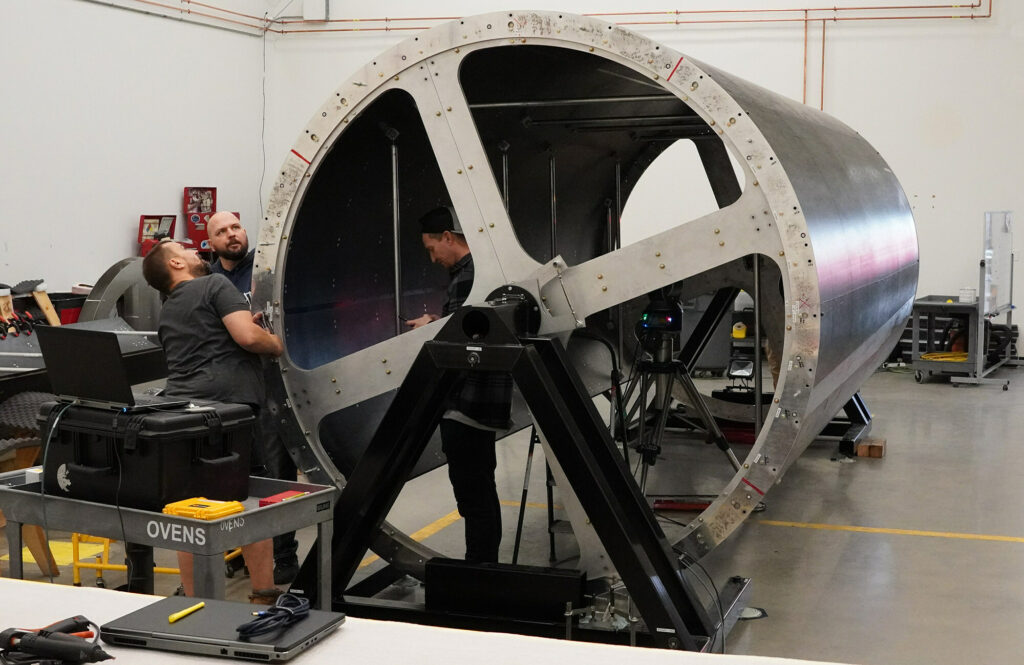
The Rock West Composites team works to manufacture the BTL Tracker Support Tube (full size hardware). (Photo courtesy Rock West Composites/PRNewswire-PRWeb)
The large carbon-fiber sandwich structure is reported to have met key performance parameters while using the most cost-effective design.
SAN DIEGO—Rock West Composites (RWC) reported in March that it delivered a large high-precision, carbon fiber and honeycomb core tube—the Barrel Timing Layer (BTL) Tracker Support Tube—to Purdue University.
The large carbon fiber sandwich structure, destined for CERN (the European Organization for Nuclear Research, is part of an upgrade to CERN’s Compact Muon Solenoid (CMS), a general-purpose detector at the Large Hadron Collider. It was designed by a joint team from Purdue University and Rock West Composites, the company said in a release. CERN, the world’s leading laboratory for particle physics, is located near Geneva, Switzerland.
The Purdue team was led by Andy Jung, Ph.D., and Ben Denos, Ph.D.; the Rock West Composites team was by led by John Marks, vice president of product development. The collaborative effort is reported to have met key performance parameters using the most cost-effective design. The hardware that Rock West Composites delivered was to be integrated with instrumentation from Purdue prior to delivery to CERN, according to the release.
The carbon fiber tube supports the heart of the upgraded CMS detector, a “camera” with more than a billion pixels to record proton-proton collisions at the highest ever-made energies and unprecedented resolution. In a few years, once fully commissioned, the upgraded CMS detector is expected to collect 10 times the data recorded so far in the hunt for new particles, and aims to understand the origins of the Universe, the release said.
The BTL Tracker Support Tube had to be manufactured from materials with extremely low radiation resistance. It needed to have a precise circular cylinder structure, be very strong and stiff, and meet an accelerated delivery schedule. Because the final tube had such challenging requirements, traditional tooling or manufacturing approaches would have been unaffordable, according to Rock West Composites.
Instead, innovative techniques were used, starting with the manufacture of curved, solid laminate arc segments rather than a full cylinder. Precision machined arc segment stiffeners help hold the arcs to strict dimensions once assembled. Low coefficients of thermal expansion are maintained in all three directions: radially, circumferentially, and along the length of the tube, the company said.
Prior to making the full-scale tube, RWC built a full diameter but much shorter version of the part as a technology demonstrator. Rock West Composites was presented with an Industry Gold Award from CERN in 2022 for this effort. The company is said to have ultimately won the program from Purdue for the full-size hardware due to the success of the demonstration model and its affordability.
The delivered hardware is 5.3-meters long by 2.4 meters in diameter. It is constructed of ultra-high-modulus prepreg and Nomex honeycomb core made with PMT-F6 cyanate ester resin. There are 1,680 metallic inserts made of solid carbon epoxy, titanium, and stainless steel; and it includes two 110 MSI carbon fiber (K13916/ F6) rails to support scientific instruments. Surface accuracy requirements were tested to 2.4mm cylindricity in-house before shipment, the company said in the release.
“We were excited to take on this challenging program and to know that we will be contributing to the advancement of humanity’s understanding the fundamental construct of matter, “ said Marks in a statement. “Our work on the demonstration model and final hardware pushed our team’s technical skills to the limit, and we couldn’t be prouder of their performance on this program.”
Rock West Composites is an advanced composites company that develops, engineers, manufactures, and tests composite products for multiple industries. Among the industries it serves are aerospace and defense (radomes, aircraft, and weapon components), Space (bus structures, solar array panels and wings, strut assemblies, launch vehicle structures), and commercial equipment (industrial, medical, energy, and sporting).
